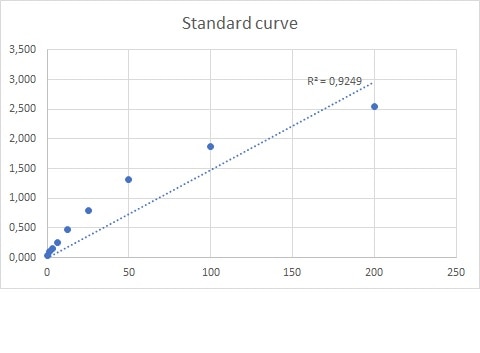Recombinant Human Thrombospondin-4 Protein, CF Summary
Product Specifications
Optimal dilutions should be determined by each laboratory for each application.
Ala22-Asn961, with a C-terminal 10-His tag
Analysis
Product Datasheets
Carrier Free
CF stands for Carrier Free (CF). We typically add Bovine Serum Albumin (BSA) as a carrier protein to our recombinant proteins. Adding a carrier protein enhances protein stability, increases shelf-life, and allows the recombinant protein to be stored at a more dilute concentration. The carrier free version does not contain BSA.
In general, we advise purchasing the recombinant protein with BSA for use in cell or tissue culture, or as an ELISA standard. In contrast, the carrier free protein is recommended for applications, in which the presence of BSA could interfere.
2390-TH
| Formulation | Lyophilized from a 0.2 μm filtered solution in Tris and NaCl. |
| Reconstitution | Reconstitute at 100 μg/mL in sterile PBS. |
| Shipping | The product is shipped at ambient temperature. Upon receipt, store it immediately at the temperature recommended below. |
| Stability & Storage: | Use a manual defrost freezer and avoid repeated freeze-thaw cycles.
|
Reconstitution Calculator
Background: Thrombospondin-4
Thrombospondin-4 (TSP-4) is an approximately 140 kDa matricellular protein that is secreted as a disulfide-linked pentamer. Within the Thrombospondin family, TSP-3 and TSP-5/COMP are also pentameric, while TSP-1 and TSP-2 are trimeric. TSP-4 regulates cell-cell and cell matrix interactions and plays a role in cardiovascular physiology and neuronal development (1, 2). Mature human TSP-4 consists of an N-terminal heparin-binding domain, a coiled coil motif, four EGF-like repeats, seven TSP type-3 repeats (one with an RGD motif), and a TSP C-terminal domain (2). Human TSP-4 shares 93% amino acid sequence identity with mouse and rat TSP-4. TSP-4 binds a variety of matrix proteins including Collagens I, II, III, V, Laminin-1, Fibronectin, and Matrilin-2 (3). Interactions of TSP-4 with non-collagenous proteins are independent of divalent cations, whereas interactions with collagenous proteins are enhanced in the presence of zinc (3). TSP-4 binds to cell surface Integrins containing the alpha M, beta 2, or beta 3 chains (4, 5). It is expressed in skeletal muscle and tendon as well as by vascular smooth muscle and endothelial cells (6‑8). It is up‑regulated in cardiomyocytes during pressure overload and is required for mediating the responsive increase in cardiac contractility (9). In humans, a polymorphism of TSP-4 (A387P) is associated with myocardial infarction (10). TSP-4 contributes to the development of inflammation and atherosclerosis by promoting macrophage and neutrophil adhesion to the vasculature (4, 5). In the nervous system, TSP-4 is expressed by astrocytes and neurons and is enriched at neuromuscular junctions and synapse-rich layers of the brain and retina (8, 11, 12). It promotes neuronal adhesion, neurite outgrowth, and excitatory synaptogenesis (8, 12, 13). TSP-4 is
up‑regulated in the spinal cord following peripheral nerve injury where it contributes to presynaptic hypersensitivity and hyperalgesia (11). It is also up‑regulated in muscle following denervation (8). TSP-4 is additionally secreted by tumor-associated fibroblasts in gastric adenocarcinoma, particularly in regions of tumor cell invasion (14).
- Murphy-Ullrich, J.E. and R.V. Iozzo (2012) Matrix Biol. 31:152.
- Lawler, J. et al. (1995) J. Biol. Chem. 270:2809.
- Narouz-Ott, L. et al. (2000) J. Biol. Chem. 275:37110.
- Pluskota, E. et al. (2005) Blood 106:3970.
- Frolova, E.G. et al. (2010) Circ. Res. 107:1313.
- Sodersten, F. et al. (2007) Connect. Tiss. Res. 48:254.
- Stenina, O.I. et al. (2003) Circulation 108:1514.
- Arber, S. and P. Caroni (1995) J. Cell Biol. 131:1083.
- Cingolani, O.H. et al. (2011) Circ. Res. 109:1410.
- Stenina, O.I. et al. (2007) Arterioscler. Thromb. Vasc. Biol. 27:1886.
- Kim, D.-S. et al. (2012) J. Neurosci. 32:8977.
- Dunkle, E.T. et al. (2007) Exp. Eye Res. 84:707.
- Eroglu, C. et al. (2009) Cell 139:380.
- Forster, S. et al. (2011) Mod. Pathol. 24:1390.
Citation for Recombinant Human Thrombospondin-4 Protein, CF
R&D Systems personnel manually curate a database that contains references using R&D Systems products. The data collected includes not only links to publications in PubMed, but also provides information about sample types, species, and experimental conditions.
1 Citation: Showing 1 - 1
-
Deficiency of Thrombospondin-4 in Mice Does Not Affect Skeletal Growth or Bone Mass Acquisition, but Causes a Transient Reduction of Articular Cartilage Thickness.
Authors: Jeschke A, Bonitz M, Simon M, Peters S, Baum W, Schett G, Ruether W, Niemeier A, Schinke T, Amling M
PLoS ONE, 2015-12-02;10(12):e0144272.
Species: Porcine
Sample Types: Whole Cells
Applications: Bioassay
FAQs
No product specific FAQs exist for this product, however you may
View all Proteins and Enzyme FAQsReviews for Recombinant Human Thrombospondin-4 Protein, CF
Average Rating: 5 (Based on 2 Reviews)
Have you used Recombinant Human Thrombospondin-4 Protein, CF?
Submit a review and receive an Amazon gift card.
$25/€18/£15/$25CAN/¥75 Yuan/¥2500 Yen for a review with an image
$10/€7/£6/$10 CAD/¥70 Yuan/¥1110 Yen for a review without an image
Filter by:




